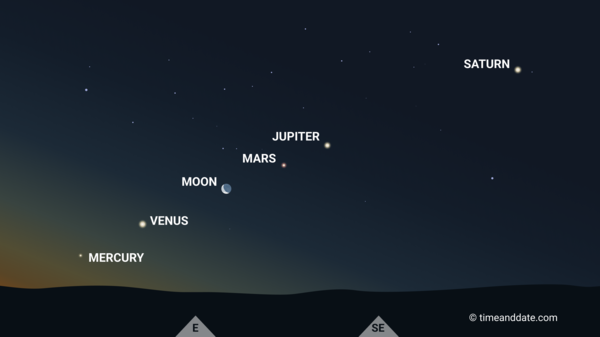
This graphic shows the pre-dawn alignment of the classical planets, to be seen in the United States just before Sunrise 2022 June 23 to 25. (Graphic Source: TimeandDate.com)
By Glenn A. Walsh
Reporting for SpaceWatchtower
A beautiful alignment of the classical planets will be visible in the early morning sky, just before Sunrise, at the end of this week (weather-permitting). The non-profit group, Astronomers Without Borders, has voted this planetary alignment one of their top “Sky Events” for this year!
In the early morning hours, Thursday through Saturday, the classical planets known throughout human history will be visible, in their actual order from the Sun.
The classical planets, the “wanderers” in the Earth's sky, are the planets, plus the Sun and Moon, observed via the unaided or naked-eyes (one-power) by our ancestors for millenia. These planets were observed long before there was any written history or other documents. And, of course, long before famous Italian astronomer Galileo Galilei observed planets with his first astronomical telescope in January of 1610 (coincidentally, it was June 22 in 1633 when Galileo was sentenced to house-arrest for the rest of his life, due to his published scientific papers, by the Palace of the Holy Office in Rome). Hence, no one knows who first discovered these planets.
These planets, which will be seen in order rise east-to-southeast from the horizon: Mercury, Venus, Mars, Jupiter, and Saturn (their actual order of distance from the Sun). The ancients also placed the Sun and Moon in the wanderer category. The ancients observed that these celestial bodies did not act the same as the other stars in the sky.
While all other “fixed” stars and constellations in the sky moved together, harmoniously, across the sky each night, these five planets, along with the Sun and Moon, wandered throughout the sky. Hence, they were termed the wanderers or wandering stars. The word planet is derived from the Greek word planetes, which means wanderer.
While the alignment will look near-perfect to observers on Earth, this is actually an illusion of perspective. While the planets will be the correct order, from their distance from the Sun, they would not appear as such an alignment if the observer was in Outer Space or on another planet.
The best time to view this alignment will be about 45-to-60 minutes before local Sunrise. Mercury, the smallest classical planet, will be the most difficult to spot. Mercury is always seen close to the Sun, because it is the closest planet to the Sun.
At peak altitude above the horizon, Mercury will only reach a maximum of 14 degrees above the horizon. So, Mercury will be tricky to find. If you cannot find Mercury one morning, simply try a little earlier the next morning.
And, because Mercury is so low in the sky, people in locations further north than the northern part of the United States, such as in Toronto or London, may not be able to find Mercury.
These five planets may still be visible for another week or so, beyond this week. However, the alignment may not be as impressive, as the planets move apart.
Mercury may be visible a few days into the new month of July. However, on July 16 Mercury will move into Superior Conjunction, when Mercury moves very close to the Sun (from an observer's perspective) and on the opposite side of the Solar System from Earth. At that time, Mercury is not visible at all.
UNLESS YOU HAVE THE PROPER TRAINING, NEVER USE BINOCULARS OR A TELESCOPE TO TRY TO FIND MERCURY. SHOULD THE SUN RISE UNEXPECTEDLY, AND ENTER YOUR TELESCOPE OR BINOCULARS, IT COULD CAUSE PERMANENT EYE DAMAGE TO THE OBSERVER!!!
Internet Links to Additional Information ---
Classical Planets: Link >>> https://en.wikipedia.org/wiki/Classical_planet
Superior Conjunction: Link >>> https://en.wikipedia.org/wiki/Conjunction_(astronomy)#Superior_and_inferior
Source: Glenn A. Walsh Reporting for SpaceWatchtower, a project of Friends of the Zeis
Wednesday, 2022 June 22.
Like This Post? Please
Share!
More
Astronomy & Science News - SpaceWatchtower Twitter
Feed:
Link >>> https://twitter.com/spacewatchtower
Astronomy & Science Links: Link >>>
http://buhlplanetarium.tripod.com/#sciencelinks
Want to receive SpaceWatchtower blog
posts in your in-box ?
Send request to < spacewatchtower@planetarium.cc
>.
gaw
Glenn A. Walsh, Informal Science Educator
&
Communicator
(For more than 50 years! - Since Monday Morning, 1972 June 12):
Link >>> http://buhlplanetarium2.tripod.com/weblog/spacewatchtower/gaw/
Electronic
Mail: < gawalsh@planetarium.cc >
Project
Director, Friends of the Zeiss: Link >>> http://buhlplanetarium.tripod.com/fotz/
SpaceWatchtower
Editor / Author: Link >>> http://spacewatchtower.blogspot.com/
Formerly
Astronomical Observatory Coordinator & Planetarium Lecturer,
original Buhl Planetarium & Institute of Popular Science (a.k.a.
Buhl Science Center), Pittsburgh's science & technology museum
from 1939 to 1991.
Formerly Trustee, Andrew Carnegie Free Library
and Music Hall, Pittsburgh suburb of Carnegie, Pennsylvania.
Author
of History Web Sites on the Internet --
* Buhl Planetarium,
Pittsburgh: Link >>> http://www.planetarium.cc Buhl Observatory: Link >>> http://spacewatchtower.blogspot.com/2016/11/75th-anniversary-americas-5th-public.html
*
Adler Planetarium, Chicago: Link >>> http://adlerplanetarium.tripod.com
*
Astronomer, Educator, Optician John A. Brashear: Link >>> http://johnbrashear.tripod.com
*
Andrew Carnegie & Carnegie Libraries: Link >>> http://www.andrewcarnegie.cc
No comments:
Post a Comment